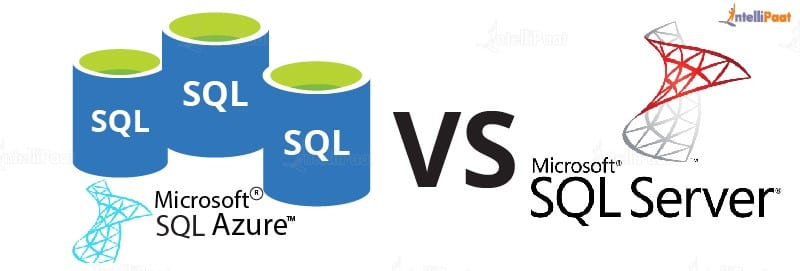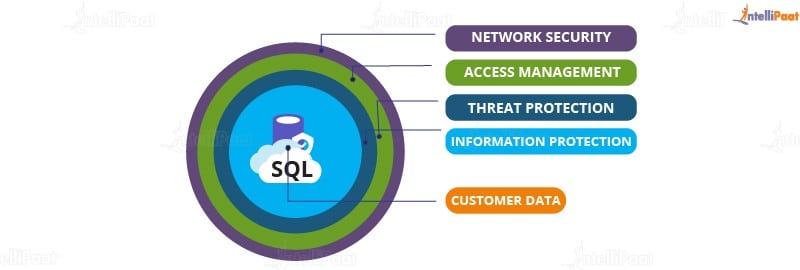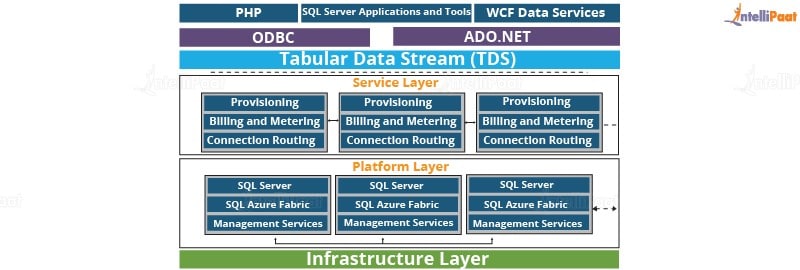1. Overview of Azure SQL
Azure SQL is a family of managed, secure, and intelligent SQL database services, which provide a range of deployment options such as single databases, elastic pools, and managed instances.
Key Benefits:
- Fully managed services
- Scalability and performance
- Built-in intelligence
- Comprehensive security
- High availability and disaster recovery
2. Azure SQL Deployment Options
Infrastructure-as-a-Service (IaaS)
SQL Server on Azure Virtual Machines:
- Best for lift and shift of workloads requiring 100% SQL Server compatibility and OS-level access.
- Ideal for applications that need SQL Server features not yet supported in Azure SQL Database.
Platform-as-a-Service (PaaS)
Azure SQL Managed Instance:
- Best for modernizing existing apps.
- Provides near 100% compatibility with SQL Server.
- Combines the best features of SQL Server with the operational and financial benefits of an intelligent, fully managed service.
Azure SQL Database:
- Best for modern cloud applications.
- Offers built-in high availability, backups, and other PaaS features.
3. Key Features of Azure SQL Database
Azure SQL Database offers several powerful features designed to simplify database management:
- Scalability: Easily scale your database resources up or down based on demand, ensuring optimal performance without downtime.
- High Availability: Benefit from built-in high availability and automated backups, reducing the risk of data loss.
- Security: Utilize advanced security measures, including encryption, threat detection, and access control, to safeguard your data.
- Intelligence: Utilize intelligent query processing for improved performance and automated tuning for optimal query execution.
- Compatibility: Effortlessly transfer your existing SQL Server applications to Azure SQL Database with minimal changes.
- Cost-Efficiency: Pay for what you use with flexible pricing models, allowing cost optimization for varying workloads.
Azure SQL vs. SQL Server
Azure SQL is a relational database platform that is present in the cloud where users can host the data and use it as a service. You can pay for what you have used, like all other cloud services. Azure SQL is built based on the SQL Server and hence it can be quite confusing when making a choice between the two as they share similar qualities. Despite being familiar, there are pretty evident differences that can help you decide which one to choose.

Let us compare the two.
| Azure SQL | SQL Server |
| One database can host several databases from different customers. | Databases are the only objects on the server. |
| It uses the Tabular Data Stream (TDS) protocol. | It uses TCP/IP protocol for communication. |
| Direct communication is not possible due to the complex architecture. | Direct communication can happen. |
| Management and administration are easy. | It is difficult to set up and administer. |
| It is easy to use as you do not need any physical hardware. | Working with a physical system is tiring. |
| It involves automatic backup. | It involves manual scheduling of backup. |
Now that you have seen the differences between Azure SQL and SQL Server, which one will you opt for?
If you are worried about your data being vulnerable in the cloud, here is why Azure SQL should be your choice:
To ward off any threat to customer data, firewalls prevent access to the database server unless it is explicitly granted based on IP address. How to configure the firewall is shown in the hands-on part.
Access is given based on a user’s roles after a thorough authentication of the user.
Azure SQL supports two types of authentication:
- SQL authentication
- Azure Active Directory authentication

With advanced threat protection, it detects any anomaly in accessing or while using the database.
In addition to all these layers, Information Protection ensures that the data is encrypted while in use and in motion.
You can be sure that your data is going nowhere if it is in Microsoft SQL Azure Database. Details on how to secure Azure SQL is will be explained in the next section with its architecture.
SQL Azure Architecture
In this Microsoft Azure SQL database Tutorial for beginners, let’s discuss Azure SQL architecture.
There are four layers in Azure SQL Architecture:
- Client Layer
- Service Layer
- Platform Layer
- Infrastructure Layer

Now, let us briefly understand each layer one by one.
Client Layer
To be able to access SQL Database, the client layer acts as an interface for applications. It includes SQL Server tools, Open Database Connectivity (ODBC), ADO.NET, and Hypertext Preprocessor (PHP).
Tabular Data Stream (TDS) transfers data between applications and SQL Databases and also communicates with applications. Hence, ADO.NET and ODBC can connect to SQL without any additional demands.
Service Layer
The next layer in the architecture is the service layer, which is in between the platform and the client layers, that acts as a doorway between the two. As you can see in the diagram, provisioning, billing, and routing connections come under this layer. It validates Microsoft Azure SQL Database requests and authenticates a user. Also, it establishes a connection between the client and the server and routes packets through this connection.
Platform Layer
This layer has systems (data nodes) that host the actual Azure SQL Server in the data center. Each SQL Database is stored in one of the nodes and is replicated twice across two different physical servers. Azure SQL makes sure that multiple copies of servers are kept within the Azure Cloud. It also ensures that the copies are synchronized when clients manipulate their data on them.
Infrastructure Layer
This is the first layer from the bottom of the architecture and is responsible for the administration of the OS and the physical hardware.
So, these were the layers and the architecture of Azure SQL.
Microsoft Azure SQL Database Pricing
In this section, a single database will be discussed without touching managed instances and elastic pools.
For a single database, the vCore-based purchase model is the best to opt for because it is flexible and allows you to scale memory and storage based on your needs. Using the serverless compute tier optimizes price and performance.
For 1 GB, you are charged Rs.9.1213/month, but you can scale up your space up to 512 GB.
For weekly backups, your database is copied to RA-GRS and it will cost you Rs.15.864/month.
The pricing model will become even clearer in the next section. So, let us quickly move on to it.
Details : https://azure.microsoft.com/en-us/pricing/details/azure-sql-database/single/
Azure SQL Database Tiers
Microsoft Azure SQL Database offers a variety of service tiers that are suited to diverse workload requirements and budget constraints. Each tier provides a unique combination of computing, storage, and I/O resources, enabling you to optimize your database performance and cost-effectiveness. The following tiers are elaborated below:
- Basic Tier: Designed for light workloads and small databases, offering a cost-effective entry point to Azure SQL Database with basic features.
- Standard Tier: Provides balanced performance and storage, suitable for mid-sized databases and moderate workloads, offering improved capabilities over the Basic tier.
- Premium Tier: Designed for high-performance needs, offering advanced features, high throughput, and low latency, and it is best suited for critical applications and heavy workloads.
- General Purpose Tier: Offers a good balance between performance and cost, and is suitable for a wide range of workloads, providing flexibility and scalability.
- Hyperscale Tier: Designed for massive scalability and performance, especially suited for applications with unpredictable workloads or heavy analytical processing.
Azure SQL Database Services
Microsoft Azure SQL Database goes beyond providing an effective cloud database service. It offers an extensive set of additional services that enhance your data management capabilities and address a wide range of data-related needs.
Azure SQL Database Managed Instance:
Azure SQL Database Managed Instance provides a fully managed SQL Server database engine in the cloud. It allows lifting existing SQL databases to Azure with minimal changes. Microsoft manages the database engine, so there are automatic updates and patches without downtime. Developers get full SQL Server functionality and tools in a scalable and cost-effective cloud environment with built-in security and disaster recovery features.
Azure SQL Database Managed Backup:
Data loss creates a significant risk to any organization, and Azure SQL Database Managed Backup reduces this risk by automating database backup management. This service ensures that your backups are regularly created, stored securely, and readily available for point-in-time restoration in case of data loss or corruption.
Azure SQL Database Threat Detection:
In today’s cybersecurity environment, protecting your data from evolving threats is most important. Azure SQL Database Threat Detection makes use of advanced machine learning algorithms to safeguard your database against potential security breaches. Real-time threat detection, vulnerability scanning, and threat investigation tools provide a comprehensive approach to identifying, analyzing, and reducing security threats.
Differences Between Azure SQL Database, SQL Managed Instance, and SQL Server on Azure Virtual Machines
| Feature/Aspect | Azure SQL Database | SQL Managed Instance | SQL Server on Azure Virtual Machines |
|---|---|---|---|
| Deployment Model | PaaS | PaaS | IaaS |
| Management | Fully managed by Azure | Fully managed by Azure | Customer-managed |
| Compatibility | High, but limited compared to SQL Server | Near full SQL Server compatibility | Full SQL Server compatibility |
| Use Cases | Modern cloud apps, scalable workloads | Lift-and-shift SQL Server workloads | Complete control, custom configurations |
| Scaling | Elastic pools, automatic scaling | Manual scaling, supports high concurrency | Manual scaling |
| Networking | Public endpoints, VNet service endpoints | VNet integration, private endpoints | Full control over networking |
| Maintenance | Automated updates and patching | Automated updates and patching | Manual updates and patching |
| High Availability | Built-in with service tiers | Built-in, multiple replicas | Configurable with availability sets |
will be Continued................


No comments:
Post a Comment
Thanks for your valuable comment...........
Md. Mominul Islam